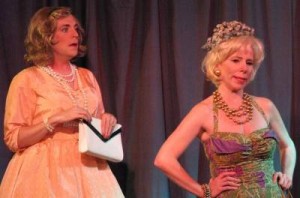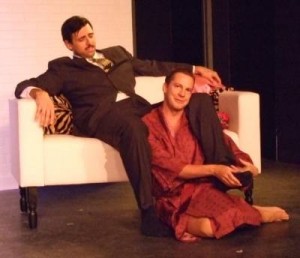RECOMMENDED
No one spoofs classic Hollywood movie genres better than Charles Busch. Whether it be the Ross Hunter women’s pictures of the 1950s and 60s (Die! Mommie! Die!) or Frankie and Annette Beach Party flicks (Psycho Beach Party) or WWII spy epics (The Lady In Question), Busch knows his Hollywood backwards and forwards. The more his audience knows about movie styles and movie stars, the funnier Busch’s plays are, but even those not so familiar with names like 1950s TV staples Kate Smith, Dagmar, and Norman Vincent Peale will find laughs aplenty in Red Scare On Sunset, which lampoons (and pays tribute to) late 40s/early 50s red-baiting propaganda films like Red Menace, I Married A Communist, and My Son John.
Red Scare On Sunset centers on glamorous Hollywood star Mary Dale, who begins to suspect that her hunky leading man husband Frank Taggart just might be … a communist! Not good news at all in 1951 Hollywood, where real life red-baiters like Ginger Rogers, Hedda Hopper, Elia Kazan, and Adolphe Menjou were naming names and destroying careers left and right in the name of freedom, justice, and the American Way. (Well, actually it was only those on the left whose careers were destroyed.) As Act 1 opens, “comedy legend” (and Mary’s best friend) Pat Pilford has just given Pat Pilford Radio Show regular (and suspected communist) Ralph Barnes the pink slip mid-program, and announced to her listeners that “the time has come for all of us to clean house.”
As in most other plays in the Busch oeuvre, Red Scare On Sunset’s lead female character is written to be played by a man in drag. Though no one does this quite as well as Busch himself (check out the movie versions of Die! Mommie! Die! and Psycho Beach Party), Drew Droege comes in a close second in the Attic Theatre’s rough-around-the-edges but hilarious revival. In a comic tour de force performance, Droege mixes bits of Bette Davis, Loretta Young, Dorothy Malone, Jane Wyman, Donna Reed, Mercedes McCambridge, and Bea Arthur to create a fabulous soufflé of a Hollywood star. Opposite Droege in the role of brassy, no-nonsense, hard-bitten, wise-cracking Pat Pilford, Michelle Begley positively crackles. As Mary’s hubby Frank, 6’5” mustachioed hunk Chris Tarantino looks and sounds just like the 1950s movie star he’s playing, and knows exactly how to deliver Busch lines like “What does a cold metal thing like a camera know about a beautiful woman?” in perfect 50s style. (Remember that in pre-Brando Hollywood, actors were taught that “technique plus timing equals talent.”)
All the hallmarks of a Busch comedy are to be found in Red Scare On Sunset, among them snappy dialog jam-packed with 50s slang. “A shot of hootch would be tempting, but I’d better say nix,” responds Pat to Mary’s offer of a Rob Roy. Pat calls actress Marta Towers “the most notorious pinko in Hollywood” and “an institution like Southern California Gas” who’s “had more Russians in her than the Kremlin.” Mary tells Frank, “Buster, Godiva was a lady and so am I,” and later Pat declares, “How many times must I tell people. Ideas are dangerous. Squash ‘em!”
As Mary, Droege knows well that Busch heroines are wont to put their own stamp on certain words, as he does to hilarious effect by pronouncing privacy a l’anglaise as privvacy, telling Indiana native Marta that she’s “a fellow Hooozeeyer” and referring to screenwriter-producer Dore Schary as “Doré.”
Besides dropping real Hollywood names, both famous and obscure, Busch has his usual field day inventing improbable monikers like “Moishe Nisowitz” (Frank’s real name) or that of Mary’s high school dramatics coach “Miss Helen Phipps” or a certain “Commissar Olga Shumsky.”
I love those quintessential Busch moments, such as when the playwright has Mary interrupt Frank in the midst of a loud shouting match the two are having in order to comment in astonishment, “Oh Frank darling. We’re nearly arguing,” accent on the nearly, or when an angry Mary informs hubby in no uncertain terms that “our twin beds are off limits,” or when Mary explains away a suicide by saying that the deceased “lived in such sorrow all his life, existing in that bizarre lonely nertherworld of half-men.”
In supporting roles, Dane Whitlock is a gay delight as Mary’s houseboy Malcolm, once part of Republic pictures makeup department until Pat had him fired because she “didn’t care for the shade of red he was pushing.” Whitlock gets beaucoup laughs as Malcolm attempts to bring Frank out of his heterosexual shell by massaging his feet and declaring that his pure silk robe “feels really good cause you know, I’m nude under here” until Mary arrives and it’s seductus interruptus. As Marta Towers, Sona Tatoyan perfectly captures the heightened delivery that was a hallmark of Hollywood acting in the days before Strasberg and Meisner, and has great fun seducing method-struck Frank just by listing the titles of great plays: “‘The Wild Duck,’ ‘Baal,’ ‘When The Dead Awaken,’ ‘Blood Wedding’ …” Jan Munroe is deliciously sinister as “Yetta Felson Acting School” director Bertram Barker. Eric Jorgenson and Amy Procacci complete the cast in multiple roles.
Not everything works as well as it could in the Attic Production. The Pat Pilford Radio Show announcer could use more pep and pizzazz when giving the opening announcement/credits. A scene in which Mary, Pat, and Marta are imbibing only tea is inexplicably played as if the women were drunk. A couple of the supporting actors appear still to be having trouble with their lines. Occasionally, Cindy Gendrich’s otherwise spot-on direction allows actors to go a bit too much over the top. (With Busch, sometimes subtler is better.) And a scene in which Droege’s hairy legs pop out from under a hospital gown would provoke an “ixnay from Busch .” (Pig Latin always seems to make an appearance in a Busch play.)
Red Scare’s standout design element is Mary Wayne-Thomas’ costuming, most particularly the gowns she has created for Droege to wear, including a tutti-frutti chiffon number that positively glows in pastel pinks and greens. High marks too for Begley’s many colorful full-skirted ensembles and chapeaux. Ali Deyer’s lighting design makes appropriately clever use of the color red and Cindy Gendrich’s sound design incorporates some suitably melodramatic 50s style movie soundtrack music, though an attempt to make the Pat Pilford Radio Show opening announcements sound as if they were being broadcast over the radio simply makes them difficult to understand and laughs are lost. Wayne-Thomas’s set design does its darndest under the production’s budgetary limits.
When Red Scare On Sunset first opened in 1991, Busch was criticized by some who felt that by making red-baiters its heroes, he was “championing the suppression of creative freedom.” Yet to have made them the villains, he would have had to subvert the movie genre he was paying homage to. A gutsy decision, but one absolutely fitting a play which so devilishly satirizes movies which saw the world in shades of red … and good.
Whether you’re a Charles Busch fan or a neophyte, there is much pleasure to be gotten from the Attic’s production of Red Scare On Sunset.
The Attic Theatre, 5429 W. Washington Blvd., Los Angeles.
www.plays411.com/redscare
–Steven Stanley
September 21, 2008




 Since 2007, Steven Stanley's StageSceneLA.com has spotlighted the best in Southern California theater via reviews, interviews, and its annual StageSceneLA Scenies.
Since 2007, Steven Stanley's StageSceneLA.com has spotlighted the best in Southern California theater via reviews, interviews, and its annual StageSceneLA Scenies.







 COPYRIGHT 2024 STEVEN STANLEY :: DESIGN BY
COPYRIGHT 2024 STEVEN STANLEY :: DESIGN BY